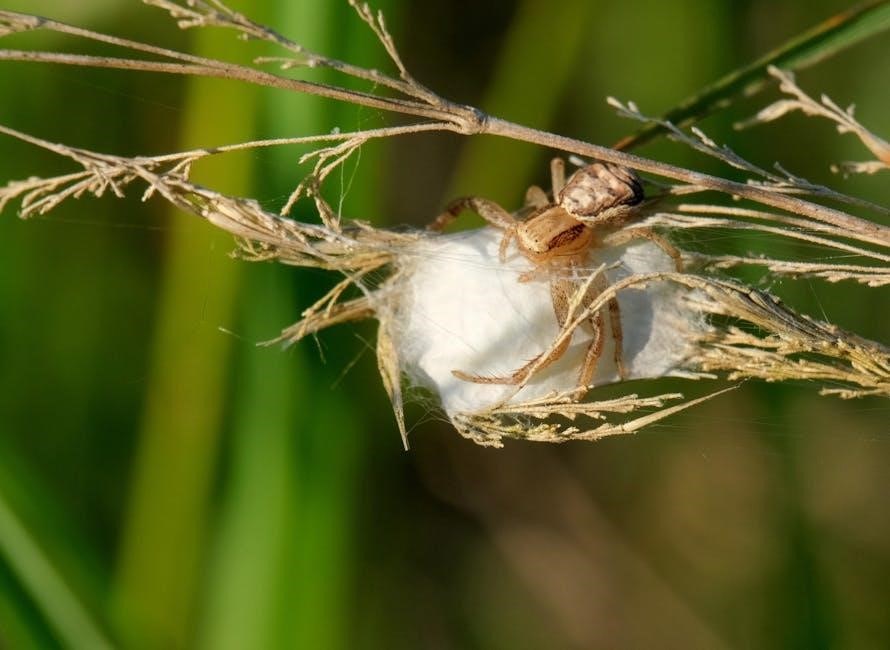Historical Context of “One Flew Over the Cuckoo’s Nest”
Ken Kesey’s novel reflects the Beats literary movement’s rejection of societal norms․ Written in 1962, it critiques 1960s government policies and the Vietnam War’s societal impact, influencing its themes of individualism and rebellion․
1․1 The Beats Literary Movement and Its Influence on the Novel
The Beats literary movement, emerging in the 1950s, emphasized nonconformity and rejection of mainstream culture․ Ken Kesey, influenced by this movement, crafted One Flew Over the Cuckoo’s Nest to critique societal norms and authoritarian structures․ The novel reflects Beat ideals through its portrayal of individualism and rebellion, particularly in the character of Randle McMurphy, who challenges the oppressive regime of Nurse Ratched․ This alignment with Beat philosophy underscores the novel’s themes of personal freedom and resistance to institutional control, resonating with the movement’s emphasis on nonconformity and authenticity․
1․2 Societal Norms and Government Policies in the 1960s
The 1960s societal norms emphasized conformity and hierarchical structures, reflecting rigid gender roles and authoritarian institutions․ Government policies, including those related to mental health and the Vietnam War, were often criticized for neglecting marginalized groups․ One Flew Over the Cuckoo’s Nest critiques these norms, portraying a mental institution as a microcosm of societal control․ The novel highlights the oppressive nature of these systems, with Nurse Ratched symbolizing the enforcement of conformity․ Kesey’s work reflects the era’s tensions, challenging the status quo and advocating for individual freedom, aligning with the countercultural movements of the time․
1․3 The Vietnam War’s Impact on the Novel’s Themes
The Vietnam War influenced Ken Kesey’s exploration of authority and rebellion in One Flew Over the Cuckoo’s Nest․ The war symbolized societal control and the suppression of individual freedom, mirroring the oppressive regime of Nurse Ratched․ McMurphy’s defiance against institutional authority paralleled the anti-war movement’s resistance to government policies․ The novel critiques the dehumanizing effects of systemic control, reflecting the era’s distrust of authority․ Kesey’s portrayal of power dynamics and conformity versus individualism resonated with the countercultural movement, drawing parallels between the mental institution and the broader societal structures of the 1960s․
Major Themes in “One Flew Over the Cuckoo’s Nest”
The novel explores themes of individualism vs․ conformity, power dynamics, and freedom vs․ institutional control, reflecting societal tensions and the struggle against oppressive authority․
2․1 Individualism vs․ Conformity
The novel vividly portrays the clash between individualism and conformity, with McMurphy’s rebellious spirit challenging the rigid, oppressive atmosphere of the mental institution․ This struggle mirrors the broader societal tensions of the 1960s, where conformity was heavily enforced․ McMurphy’s defiance of Nurse Ratched’s authority symbolizes the fight for personal freedom against institutional control, emphasizing the importance of individuality in a society that often demands uniformity․ Through this dynamic, Kesey critiques the suppression of self-expression, highlighting the psychological and emotional costs of forced conformity․ The theme remains a powerful commentary on the human spirit’s need for autonomy and self-determination․
2․2 Power Dynamics and Control
The novel explores power dynamics through Nurse Ratched’s oppressive regime and McMurphy’s defiance․ Ratched wields control via strict routines, psychological manipulation, and institutional authority, maintaining order through fear and humiliation․ McMurphy, however, challenges this hierarchy, undermining her dominance and inspiring patients to resist․ Kesey portrays power as a tool of oppression, with Ratched embodying institutional control and McMurphy symbolizing rebellion․ The struggle between these characters highlights the tension between authority and individual will, critiquing systemic power structures that suppress freedom and autonomy․ This dynamic serves as a metaphor for broader societal power imbalances, emphasizing the human cost of unchecked control and manipulation․
2․3 Freedom vs․ Institutional Control
The novel starkly contrasts individual freedom with institutional control, highlighting the oppressive nature of rigid systems․ Nurse Ratched’s psychiatric hospital symbolizes a society that stifles autonomy, enforcing conformity through fear and manipulation․ McMurphy’s arrival disrupts this order, advocating for personal liberty and challenging the institution’s oppressive norms․ His defiance inspires patients to seek freedom, but the institution ultimately crushes dissent, illustrating the power of systemic control over individual will; Kesey critiques societal structures that prioritize order over freedom, emphasizing the human spirit’s struggle against oppressive regimes; This theme resonates with the 1960s counterculture, advocating for rebellion against authoritarian systems․
Key Characters in the Novel

Randle McMurphy, a rebellious patient, challenges authority, while Nurse Ratched embodies oppressive control․ Chief Bromden, a silent observer, symbolizes the institution’s impact on individual freedom and identity․
3․1 Randle Patrick McMurphy: The Rebel
Randle McMurphy is the novels central character, a boisterous and confident man who feigns insanity to avoid prison labor․ Upon entering the psychiatric institution, he immediately challenges the strict routine and authority of Nurse Ratched․ McMurphy’s rebellious nature and refusal to conform inspire the other patients, transforming the passive ward into a space of resistance․ His larger-than-life personality and defiance of institutional control make him a symbol of individualism and freedom․ Through his actions, Kesey explores themes of societal oppression and the clash between individuality and conformity, making McMurphy a powerful and enduring figure in American literature․

3․2 Nurse Ratched: The Symbol of Authority
Nurse Ratched embodies institutional authority, exerting strict control over the mental institution․ Her calm, composed demeanor hides a rigid enforcement of rules, creating an oppressive atmosphere․ She maintains order through subtle manipulation and fear, often using psychological tactics to suppress dissent․ Her desk in the glass Nurses Station symbolizes her surveillance and power over the patients․ Ratched’s adherence to routine and her use of controversial treatments like shock therapy highlight her role as a symbol of societal conformity and institutional control, making her a formidable opponent to McMurphy’s rebellious nature and a representation of oppressive authority․
3․3 Chief Bromden: The Silent Observer
Chief Bromden, a patient in the mental institution, appears mute and passive, observing events silently․ His towering presence contrasts with his quiet nature, making him an enigmatic figure․ Despite his silence, Bromden is acutely aware of the dynamics around him, particularly the power struggle between McMurphy and Nurse Ratched․ His character serves as a symbol of oppression and the crushing effects of institutional control․ Bromden’s eventual transformation, inspired by McMurphy’s defiance, highlights his inner strength and the possibility of breaking free from societal constraints․

Plot Structure and Development
The plot revolves around McMurphy’s arrival, his defiance of Nurse Ratched, and the subsequent power struggle, leading to his tragic downfall and the patients’ subtle liberation․
4․1 The Setting: The Mental Institution
The story unfolds in a psychiatric hospital, a rigid, oppressive environment symbolizing societal control․ The institution, with its sterile halls and strict routines, embodies the oppressive structures of 1960s America․ Nurse Ratched’s glass-enclosed station serves as the center of authority, where she monitors and controls the patients․ The setting reflects the broader societal norms of conformity and institutionalized oppression․ The hospital’s atmosphere is tense and intimidating, with controversial treatments like shock therapy and lobotomy highlighting the era’s harsh approaches to mental health․ This backdrop amplifies the struggle between individual freedom, represented by McMurphy, and institutional control, personified by Nurse Ratched․
4․2 The Narrative Voice and Perspective
The novel is narrated by Chief Bromden, a patient in the mental institution, offering a unique, insider perspective․ Bromden’s voice provides insight into the hospital’s oppressive environment and the patients’ struggles․ His narration, initially fragmented, gradually clarifies, mirroring his growing awareness․ Through Bromden’s eyes, readers experience the institution’s rigid routines and the power dynamics between Nurse Ratched and the patients․ The narrative voice underscores themes of control and rebellion, while Bromden’s perceived muteness allows him to observe undetected, adding depth to the story․ His perspective highlights McMurphy’s disruptive influence and the societal pressures faced by the patients․
4․3 Key Events and Turning Points
The novel’s key events center around Randle McMurphy’s arrival at the institution, disrupting the rigid routine․ His defiance of Nurse Ratched, such as refusing to follow rules or attacking her, marks significant turning points․ The fishing trip, where McMurphy takes patients to the sea, symbolizes freedom and empowerment․ However, this act of rebellion intensifies Nurse Ratched’s determination to maintain control․ McMurphy’s eventual lobotomy, rendering him submissive, is a pivotal moment, showcasing the institution’s oppressive power․ These events highlight the struggle between individual freedom and institutional control, culminating in McMurphy’s tragic transformation and its profound impact on the patients, particularly Chief Bromden․

Portrayal of Mental Health in the Novel
The novel portrays mental health through controversial treatments like shock therapy and lobotomy, highlighting their dehumanizing effects․ The institution reflects societal oppression, emphasizing control over cure․
5․1 Controversial Treatments: Shock Therapy and Lobotomy
The novel portrays shock therapy and lobotomy as controversial and dehumanizing treatments used to control patients․ These methods, often depicted as tools of oppression, highlight the institution’s focus on conformity over healing․ Shock therapy is shown to induce fear and submission, while lobotomy is used to erase individuality, leaving patients emotionally numb․ Kesey critiques these practices as inhumane and symbolically oppressive, reflecting the era’s harsh attitudes toward mental illness․ The novel’s portrayal of these treatments underscores the tension between individual freedom and institutional control, resonating with the counterculture movement’s rejection of oppressive societal norms․

5․2 The Stigma Surrounding Mental Illness
The novel highlights the deep-seated stigma surrounding mental illness in the 1960s․ Society viewed the mentally ill as outcasts, often dismissing their humanity․ Kesey’s portrayal of the institution’s rigid hierarchy and dehumanizing treatments reflects this stigma; Patients are seen as lesser beings, subjected to control rather than care․ The novel critiques societal attitudes that equate mental illness with weakness, emphasizing the emotional and psychological damage caused by such stereotypes․ This stigma is further reinforced by Nurse Ratched’s authoritarian regime, which perpetuates fear and misunderstanding of mental health issues, mirroring broader societal prejudices of the time․
5․3 The Institution as a Reflection of Society
The mental institution in the novel serves as a microcosm of societal structures, highlighting oppressive norms and control mechanisms․ The rigid routines, authoritarian leadership, and dehumanizing treatments mirror the broader societal tendency to suppress individuality․ Nurse Ratched’s regime embodies the systemic enforcement of conformity, reflecting how society marginalizes those deemed “different․” The institution’s practices, such as lobotomy and shock therapy, symbolize society’s fear of nonconformity and its willingness to erase dissent․ Kesey uses the institution to critique how societal systems often prioritize control over compassion, silencing voices that challenge the status quo․ This reflection underscores the novel’s broader commentary on societal oppression and the loss of individual freedom․

Symbolism in the Novel
The cuckoo’s nest symbolizes confinement and societal oppression, while the fishing trip represents freedom and rebellion․ The Combine reflects industrial and societal control, reinforcing Kesey’s critique of conformity and individual freedom․
6․1 The Cuckoo’s Nest as a Symbol

The cuckoo’s nest symbolizes the oppressive mental institution and societal control․ It represents a place where individual freedom is stifled, mirroring the patients’ confinement․ The nest itself, a natural yet fragile structure, contrasts sharply with the rigid, artificial environment of the institution․ Ken Kesey uses this imagery to critique the ways society isolates and controls those deemed different․ The nest also reflects the characters’ inner struggles, particularly McMurphy’s rebellion and Chief Bromden’s silent resistance․ Through this symbol, Kesey highlights the tension between individuality and conformity, central to the novel’s themes of freedom and oppression․
6․2 The Fishing Trip: A Symbol of Freedom
The fishing trip in One Flew Over the Cuckoo’s Nest symbolizes freedom and liberation from institutional control․ Organized by McMurphy, it allows the patients to experience life outside the oppressive hospital walls․ The trip represents a temporary escape from Nurse Ratched’s rigid authority, giving the men a taste of autonomy and camaraderie․ For Chief Bromden, it marks a turning point, as he begins to reclaim his voice and identity․ The trip embodies the novel’s themes of rebellion and the human desire for freedom, contrasting sharply with the suffocating routines of the mental institution․
6․3 The Combine: A Symbol of Oppression
The “Combine” in One Flew Over the Cuckoo’s Nest symbolizes oppressive societal machinery that suppresses individuality․ Chief Bromden describes it as a massive, invisible force controlling people’s lives, reflecting the novel’s critique of institutional and societal oppression․ The Combine represents the dehumanizing effects of conformity and bureaucratic control, as seen in the mental institution’s rigid routines and Nurse Ratched’s authoritarian rule․ It embodies the suffocating nature of systems that stifle personal freedom and creativity, mirroring the broader societal norms of the 1960s․ The Combine’s oppressive presence underscores the novel’s themes of rebellion and the struggle for individual autonomy․
Sociocultural Impact of the Novel
One Flew Over the Cuckoo’s Nest became a cultural phenomenon, influencing the 1960s counterculture movement and advocating for mental health reform․ Its critique of oppressive systems resonated deeply․
7․1 The Counterculture Movement of the 1960s
Kesey’s novel resonated deeply with the 1960s counterculture, which sought to challenge authoritarian structures and societal norms․ The character of McMurphy symbolized rebellion against oppressive systems, echoing the era’s anti-establishment sentiment․ The novel’s themes of individual freedom and resistance to conformity aligned with the movement’s emphasis on civil rights, anti-war protests, and sexual liberation․ By portraying a mental institution as a microcosm of societal control, Kesey’s work became a powerful metaphor for the counterculture’s rejection of mainstream values․ Its influence extended beyond literature, inspiring broader critiques of institutional authority and fostering a spirit of nonconformity․
7;2 The Novel’s Influence on Mental Health Advocacy
Ken Kesey’s One Flew Over the Cuckoo’s Nest exposed the harsh realities of 1960s mental health treatment, sparking widespread criticism of inhumane practices like lobotomies and electroshock therapy․ The novel humanized patients, challenging societal stigma and advocating for their rights․ Its portrayal of institutional control and dehumanizing treatments led to increased scrutiny of psychiatric care, inspiring reforms․ The book remains a powerful tool in mental health advocacy, emphasizing the need for compassionate and ethical treatment․ Its impact continues to resonate, urging society to prioritize patient dignity and challenge oppressive systems in healthcare․
7․3 Gender Roles and Feminism in the Novel
Nurse Ratched embodies oppressive authority, symbolizing patriarchal control and societal expectations of women in power․ Her rigid, maternal dominance enforces conformity, stifling individuality and emasculating the male patients․ The novel critiques traditional gender roles, portraying men as victims of institutionalized femininity․ McMurphy’s rebellion challenges this structure, but his eventual defeat underscores the resilience of oppressive systems․ The novel’s feminist critique highlights the dangers of unchecked power and the objectification of women, though Kesey’s portrayal has been debated for its limitations in fully exploring female perspectives․ The exploration of gender dynamics remains a significant aspect of the novel’s sociocultural impact․
Adaptations and Interpretations
The novel inspired a renowned film adaptation and stage plays, reinterpretting its themes for diverse audiences․ Modern interpretations continue to explore its relevance in contemporary culture and societal issues․
8․1 The Film Adaptation: Differences and Similarities
The film adaptation of One Flew Over the Cuckoo’s Nest, directed by Miloš Forman, remains faithful to Ken Kesey’s novel while offering a unique cinematic interpretation․ Jack Nicholson’s portrayal of McMurphy captures the character’s rebellious spirit, while Louise Fletcher’s Nurse Ratched embodies authoritarian control․ The film simplifies some subplots, focusing heavily on the conflict between McMurphy and Nurse Ratched․ Key scenes, such as the fishing trip, are omitted, but the themes of freedom and conformity remain intact․ The film’s success lies in its ability to translate the novel’s emotional depth and societal critique into a visual medium, earning widespread acclaim and several Academy Awards․
8․2 Stage Play Adaptations
One Flew Over the Cuckoo’s Nest was successfully adapted into a stage play, with the Broadway production starring Kirk Douglas as Randle McMurphy․ The play captures the essence of Kesey’s novel, focusing on the power struggle between McMurphy and Nurse Ratched․ While faithful to the original story, the play simplifies certain subplots and characters, emphasizing the central conflict․ The theatrical format enhances the claustrophobic atmosphere of the institution, making the themes of freedom and control even more poignant․ The play has been revived multiple times, continuing to resonate with audiences and maintaining its relevance as a powerful critique of authority․
8․3 Modern Interpretations and Relevance
Today, One Flew Over the Cuckoo’s Nest remains a powerful commentary on individualism and institutional control․ Modern interpretations often focus on its critique of mental health systems and societal expectations․ The novel’s themes of freedom versus oppression resonate strongly in contemporary discussions about personal autonomy and systemic control․ The PDF format has made the book more accessible, allowing new generations to engage with its themes․ Its relevance extends to modern debates on mental health advocacy, patient rights, and the ethics of psychiatric treatments․ The story’s timeless appeal lies in its universal exploration of humanity’s struggle against oppressive structures, making it a enduring classic in both literature and popular culture;
Literary Devices and Style
Kesey employs a unique narrative voice through Chief Bromden, blending humor and irony to critique societal norms․ His vivid dialogue reveals character dynamics and power struggles effectively․
9․1 Ken Kesey’s Writing Style
Ken Kesey’s writing style in One Flew Over the Cuckoo’s Nest is vivid and descriptive, immersing readers in the oppressive atmosphere of a mental institution․ His use of first-person narration through Chief Bromden creates a unique perspective, blending immediacy with detachment․ Kesey’s prose explores themes of individualism and societal control, reflecting the countercultural spirit of the 1960s․ His dialogue is sharp and realistic, capturing the tension between characters like McMurphy and Nurse Ratched․ The novel’s descriptive language paints a stark picture of institutional life, while humor and irony critique the rigid systems of authority, making Kesey’s style both powerful and thought-provoking․
9․2 Use of Humor and Irony
Kesey employs humor and irony to highlight the absurdity of institutional control․ McMurphy’s antics, though rebellious, are laced with dark humor, contrasting the oppressive atmosphere․ Irony emerges in the institution’s rigid rules, portrayed as more madness-inducing than therapeutic․ The novel’s ironic tone critiques societal norms, while McMurphy’s humor humanizes the patients, challenging their passive acceptance․ The fishing trip scene blends humor with liberation, symbolizing freedom․ Kesey’s use of irony underscores the tension between individuality and conformity, making the novel both poignant and thought-provoking․ His humorous yet sharp observations amplify the novel’s critique of authority and societal expectations․
9․3 The Role of Dialogue in Character Development
Dialogue in One Flew Over the Cuckoo’s Nest is pivotal in revealing character traits and dynamics․ McMurphy’s confrontational and disruptive speech challenges Nurse Ratched’s authority, showcasing his rebellious nature․ Nurse Ratched’s calm, measured tone reinforces her control and rigidity․ The patients’ dialogues, often fragmented or hesitant, reflect their psychological struggles and gradual empowerment․ Through these interactions, Kesey highlights power imbalances and the patients’ growth․ The dialogues not only drive the plot but also deepen the audience’s understanding of the characters’ motivations and internal conflicts, making them more relatable and complex․ This dynamic interplay of voices underscores the novel’s exploration of freedom and conformity․

Critical Reception and Analysis
One Flew Over the Cuckoo’s Nest received widespread acclaim for its bold critique of societal norms and institutional control․ Critics praised its profound themes and vivid character portrayals․
10․1 Positive Reviews and Acclaim
One Flew Over the Cuckoo’s Nest has been widely praised for its powerful exploration of individualism and societal norms․ Critics acclaim its vivid portrayal of rebellion through McMurphy and the oppressive regime of Nurse Ratched․ The novel’s ability to blend humor with dark themes has been highlighted as a literary masterpiece․ Its critique of institutional control resonated deeply, making it a cornerstone of American literature․ The character development, particularly McMurphy’s symbolic struggle for freedom, has been celebrated for its depth and complexity․ The novel’s influence extends beyond literature, shaping discussions on mental health and societal norms․
10․2 Negative Criticisms and Controversies
Despite its acclaim, One Flew Over the Cuckoo’s Nest has faced criticism for its portrayal of gender roles, particularly Nurse Ratched, who has been accused of embodying misogynistic stereotypes․ Some critics argue that Kesey’s depiction of female authority figures perpetuates negative attitudes toward women․ Additionally, the novel’s portrayal of psychiatric treatments, such as lobotomy and shock therapy, has been criticized for oversimplifying complex medical practices․ Controversies also arose from its perceived glorification of nonconformity, with some interpreting McMurphy’s rebellion as promoting irresponsibility rather than genuine freedom․ These criticisms highlight the novel’s polarizing impact on readers and scholars alike․
10․3 Feminist and Marxist Interpretations
Feminist critics argue that One Flew Over the Cuckoo’s Nest perpetuates misogynistic stereotypes, particularly through Nurse Ratched, who embodies oppressive patriarchal authority․ Marxists interpret the novel as a critique of institutionalized capitalism, with the psychiatric hospital symbolizing class oppression․ The controlled environment reflects how societal structures maintain power over the marginalized․ Both perspectives highlight Kesey’s exploration of systemic control and individual freedom, offering deeper insights into the novel’s societal critique․ These interpretations underscore the novel’s relevance in understanding power dynamics and their impact on individuals and society․

The Role of the PDF Version
The PDF version enhances accessibility and convenience, offering study guides and educational resources for analyzing the novel, making it a valuable tool for students and researchers;
11․1 Accessibility and Convenience
The PDF version of One Flew Over the Cuckoo’s Nest offers unparalleled accessibility and convenience, enabling readers to access the novel anytime, anywhere․ Its digital format ensures easy portability across devices, making it ideal for students and educators․ The PDF also enhances readability with features like search functionality and adjustable font sizes, catering to diverse learning needs․ This format simplifies research and analysis, allowing users to highlight and annotate key passages effortlessly․ By providing instant access to study guides and educational resources, the PDF version fosters a deeper understanding of the novel, making it a vital tool for academic and personal enrichment․
11․2 The Importance of Digital Formats
Digital formats like the PDF version of One Flew Over the Cuckoo’s Nest are crucial in today’s tech-driven world, offering instant access to literary works․ These formats preserve the novel’s integrity while making it compatible with modern reading habits․ They enable easy sharing and storage, reducing the need for physical copies․ Digital versions also support environmental sustainability by minimizing paper use․ Additionally, features like search and bookmarking enhance reader engagement, making studying and referencing more efficient․ This adaptability ensures Ken Kesey’s masterpiece remains accessible and relevant for future generations, bridging the gap between traditional literature and contemporary technology․
11․3 Study Guides and Educational Resources
The PDF version of One Flew Over the Cuckoo’s Nest is often accompanied by study guides and educational resources, enhancing understanding for students and educators․ These resources include chapter summaries, analysis, and quotes, providing in-depth insights into themes like individualism and societal control․ They also highlight Kesey’s unique writing style and the novel’s historical context, making complex ideas more accessible․ Additionally, study guides offer discussion questions and critical perspectives, fostering engagement and critical thinking among readers․
Such resources are widely available online, catering to diverse learning needs and supporting academic exploration of the novel․ They play a vital role in education by simplifying complex themes and encouraging deeper analysis, making them indispensable for students and educators alike․
